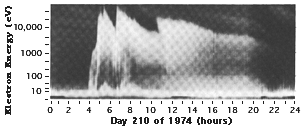
|
|
The orbital period of a satellite increases as its mean distance from Earth grows. The space shuttle in a low altitude circular orbit, just above the atmosphere, completes one circuit in about 90 minutes. It orbits some 6700 km from the Earth's center, while the moon, at 380,000 km, completes one orbit in 27.3 days. Intermediate distances go with intermediate periods, and somewhere between those two extremes is a distance where the orbital period is 24 hours. It turns out to be at about 42,000 km or 26,000 miles, some 6.6 Earth radii.
[The formula for the period T of a satellite orbiting the Earth in a circle of radius R Earth radii can be derived from Kepler's 3rd law and isA satellite orbiting above the equator at that distance keeps its position above the same spot on the ground; hence this is known as the synchronous orbit, from the Greek syn--same, chronos--time. Such an orbit is useful first and foremost for communication satellites, because a ground station linked to the satellite will always be in touch with it, as long as its antenna points to a fixed spot on the sky. The same holds for satellite dishes receiving TV broadcasts from such satellites, and of course, weather satellites designed to monitor (say) US weather will always have the proper view if parked in a synchronous orbit and facing the US. The NOAA agency of the US government ("National Oceanic and Atmospheric Administration") maintains in a set of GOES synchronous satellites to observe the weather and monitor the space environment. Images obtained by these satellites are available on the world wide web and are updated every 15 or 30 minutes. NASA's tracking network, too, uses the TDRSS Satellites (Tracking, Data and Relay Satellite System) in synchronous orbit to collect data from near-Earth spacecraft. There are currently more than 200 spacecraft in this orbit, most of them commercial communication satellites. The synchronous orbit also happens to be the approximate boundary between the sheltered near-Earth magnetosphere and the outer portions where substorms and other active changes occur. For this reason many synchronous satellites have carried detectors for magnetic fields and for trapped or injected ions and electrons. Interest in that region is driven in part by the realization that the sudden arrival there of a large number of energetic particles, as happens now and then, can charge satellites to many hundreds of volts, can create false signals in their circuitry and can even, in extreme cases, cause serious damage.
|

|
| (Above) The record of electrons intercepted by the synchronous satellite ATS 6 on 20 July 1974. The jagged peaks mark the arrival of electrons in substorms, and they gradually drift away again. The lower energies which persist belong to the plasma sheet of the magnetotail (described in a later section) in which the satellite is immersed for about half of its orbit. |
"Exploration" home page (index) Glossary
Next Stop: #15. Energy
 Official GSFC Home Page .........
Official GSFC Home Page .........
 NASA WWW Home Page
NASA WWW Home Page
Last updated March 13, 1999